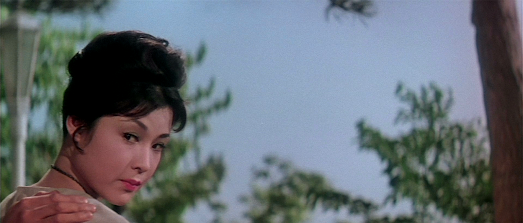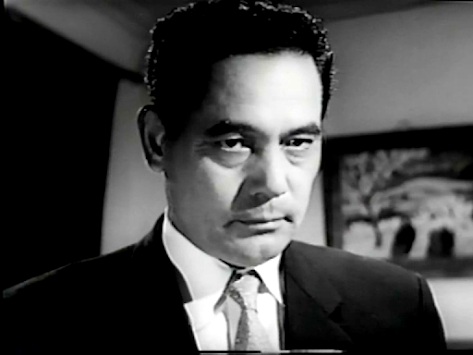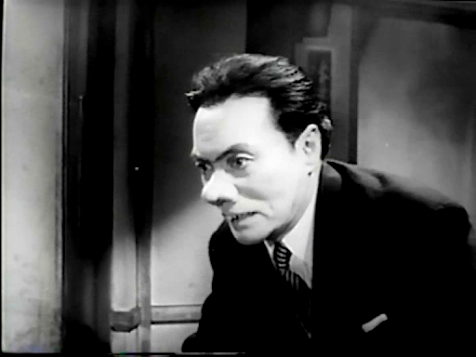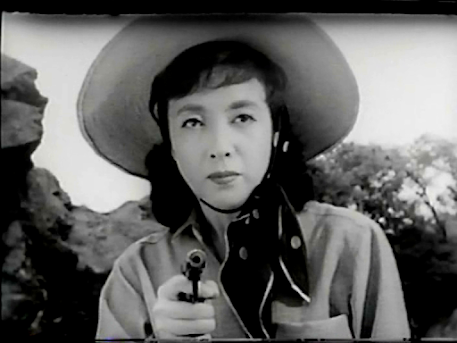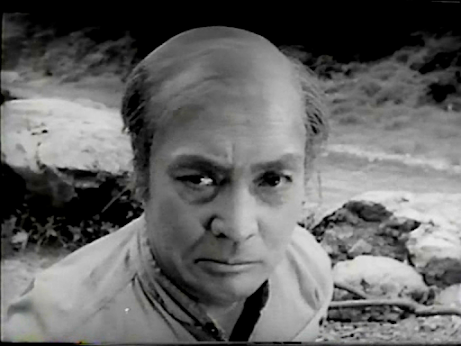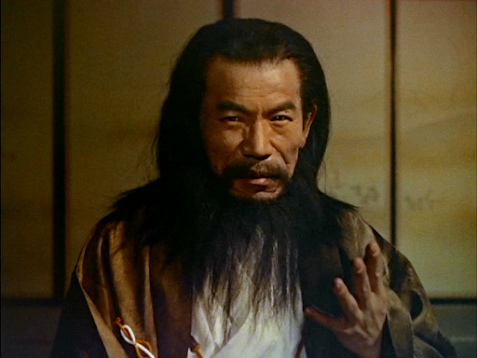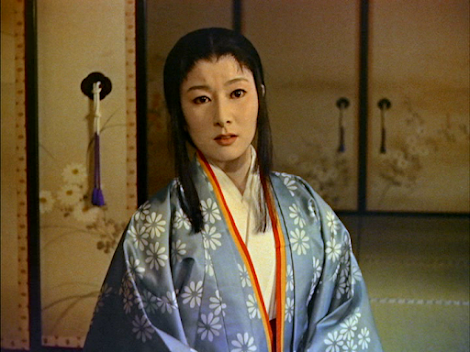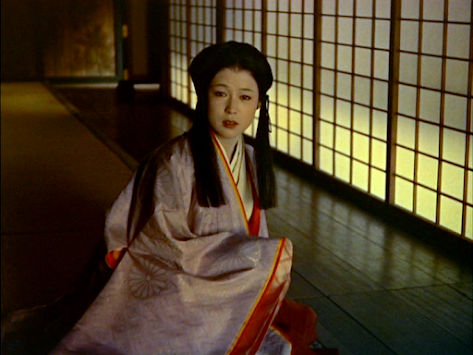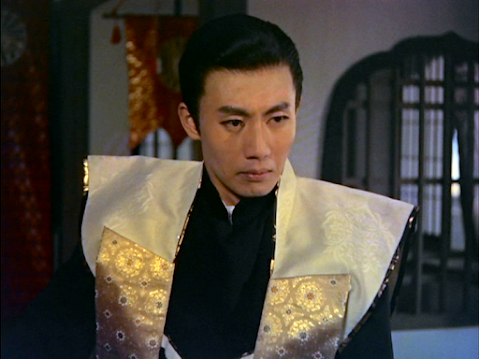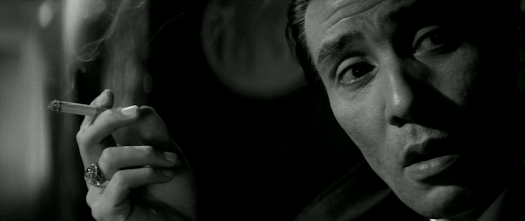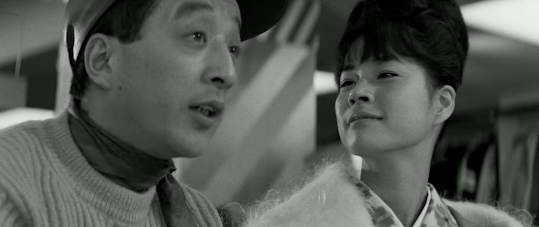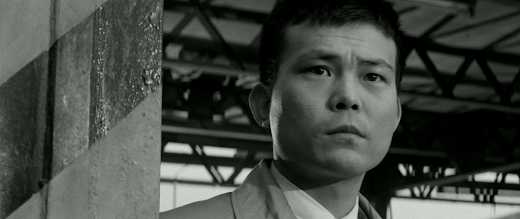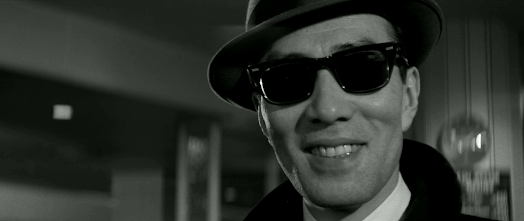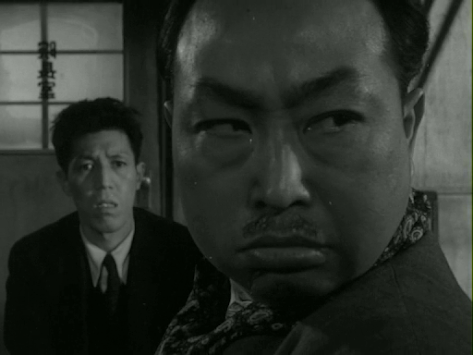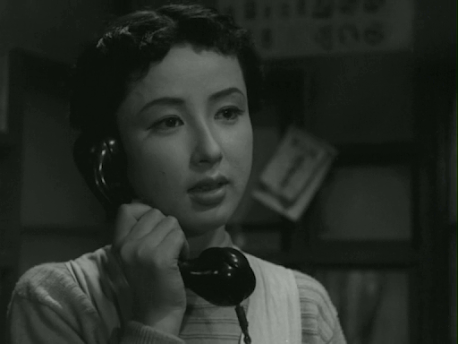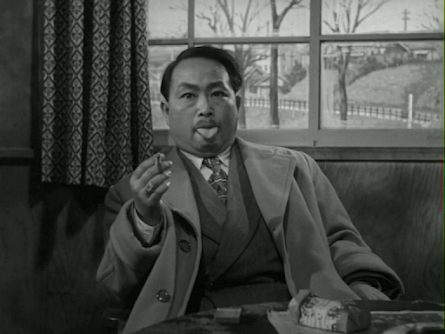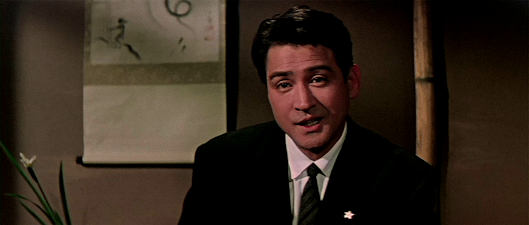M.R. Dowsing's Blog, page 14
November 30, 2023
The Spider Man / 蜘蛛男 / Kumo-otoko (1958)
Obscure Japanese Film #89
Based on a 1929 novelof the same title (yet to be translated into English) by Edogawa Ranpo, thislow-budget thriller stars Susumu Fujita in the role of Ranpo’s regular detectivecharacter, Kogoro Akechi. Fujita – best-known for playing the title role inAkira Kurosawa’s debut feature SanshiroSugata (1943) – first appears around 30 minutes in when Akechi is called into investigate a gruesome murder. A young woman has been abducted and killed whileattending a job interview, after which her dismembered body was found concealedinside a number of body sculptures. Akechi is soon on the trail of mad mastercriminal Dr. Kuroyanagi (Joji Oka), who gets his kicks out of murdering youngwomen resembling the wife who betrayed him. He next sets his sights on moviestar Yoko (Chikako Miyagi). However, using a series of increasingly bizarredisguises culminating in an outsize Cyrano de Bergerac nose, he continuallyeludes capture. His fiendish schemes reach their strange climax when he abductsa whole busload of young beauties and forces them to be models in a tableau ofhell he presents before a live audience.
TheSpider Man was originally released in two parts – the firstentitled Satsujinki Kumo-otoko (literally ‘Murderer Spider Man’) running 97 minutes, the second Kumo-otokono gyakushu (‘Spider-Man’s Counterattack’), which Ihaven’t been able to find a running time for. The version I saw displayed thetitle of part 1 in the opening credits, but was actually a re-edit of bothparts combined. It appears that each part was edited down to around 55 minutesand simply spliced together, making a total running time of 109 minutes. Theprint was a fairly low-res VHS transfer which is watchable but far from ideal.
The picture wasdirected by one Hiroyuki Yamamoto (1908-?), a name that could hardly be anymore obscure. Oddly, it was his first film since 1943 and was also to be hislast, perhaps because the production company (Shin Eiga) folded shortly afterthis was released. He first directed in 1937, and it appears that the majorityof his 11 previous films were military propaganda works.
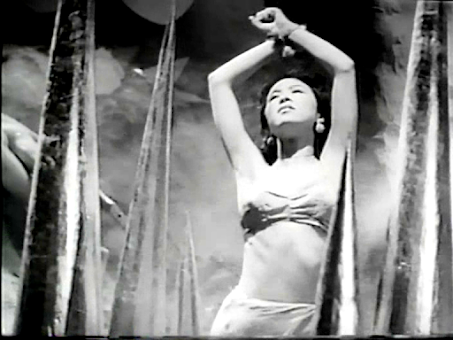
TheSpider Man is quite fast-paced, entertaining hokum which wasevidently shot quickly and cheaply. For this reason, it never fully realisesits potential and fails to make the most of its hell-tableau climax, whichcould have been far more memorable with a little extra care. Overall, the film isa fairly tame affair despite the potential nastiness of the story, and it’sperhaps just as well that it remains the only version of this particularRanpo novel given how explicit a treatment it might have been given in morerecent years.
Susumu Fujita hadplayed Akechi before in a 1948 film, Issunboshi(now lost), but mostly phones it in here. Much better value is Joji Oka, whoattacks his role with a gusto appropriately reminiscent of Lionel Atwill.Intriguingly, Oka had played Ranpo’s detective himself in a 1950 film entitled Tsurara no bijo, which received alimited Japanese DVD release in 2016 courtesy of collectors’ magazine publisherDeAgostini.
Watched without subtitles.
November 23, 2023
Portrait of Chieko / 智恵子抄 / Chieko-sho (1967)
Obscure Japanese Film #88
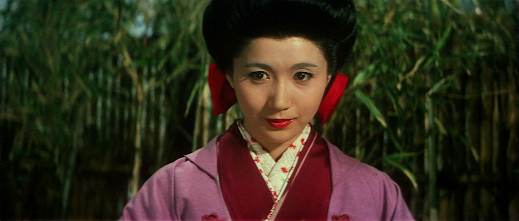 Shima Iwashita
Shima IwashitaThis Shochiku production was based on a 1941poetry collection of the same name by Kotaro Takamura (1883-1956) together witha 1957 novel entitled Shosetsu Chieko-shoby Haruo Sato, which were themselves based on the true story of Takamura’swife, Chieko (1886-1938), a painter and feminist. The story begins in 1911, atime when it was fashionable among the upper-middle class of Japan to cultivatean interest in Western art. Painter and sculptor Kotaro Takamura (TetsuroTanba) has recently returned from studying in Paris when he agrees to take on adisciple, Chieko (Shima Iwashita). The two gradually fall in love and getmarried. Although both are from fairly wealthy families, their chosenoccupation of art means they often struggle to get by. Nevertheless, for thefollowing 20 years they are mostly happy and their love remains undiminished.Then an unexpected tragedy occurs, causing Chieko to receive a severe shock, inthe wake of which she begins to act strangely. It soon becomes apparent thatshe is suffering from the onset of mental illness…
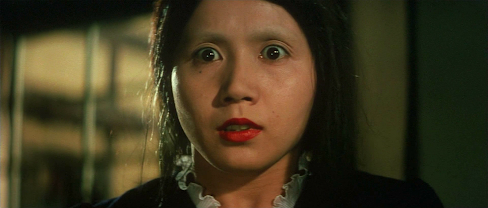 Shima Iwashita
Shima IwashitaBy 1967, sentimental love stories of this sort were becoming a rarity in Japanese cinemas flooded with yakuza flicks and monster movies, but Shochiku must have felt confident enough in the popularity of this particular story to give it the green light – an earlier film had been made in 1957 starring Setsuko Hara and So Yamamura, while there had also been a TV series, a radio drama, a number of popular songsand various books and stage plays based on the lives of Kotaro and Chieko.
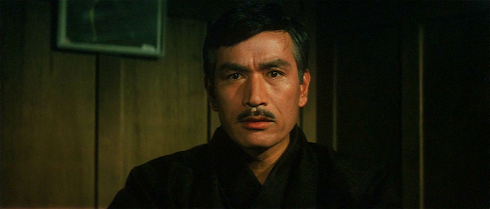 Tetsuro Tanba
Tetsuro TanbaI found the first hourof the film to be a rather bland, picture-postcard type of love story brieflyenlivened by a moment of unintentional humour when an overly-earnest youngartist slashes a painting to ribbons in a gallery, then jumps out the window Father Ted-style. However, it’s mostly amatter of watching Kotaro and Chieko being very happy together, which – let’sface it – is seldom the sort of thing to make for interesting viewing, so thingsimprove dramatically (in both senses of the word) once events take a tragicturn.
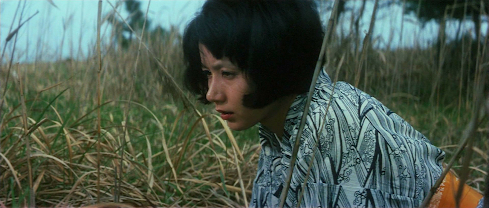 Shima Iwashita
Shima IwashitaThe film’s greateststrength is the performances of Tetsuro Tanba and Shima Iwashita, who are both perfectin their roles, with Iwashita deservedly winning a couple of awards for her highlyconvincing performance in a challenging part, while Tanba is equally good inhis less showy role. Although better known for her collaborations with her director husband, Masahiro Shinoda, this was actually one of ten films that Iwashita made fordirector Noboru Nakamura. The only other one of these I’ve seen is Koto (1963), a superior film to this one(in my opinion).
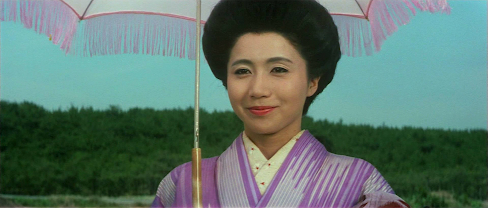 Shima Iwashita
Shima IwashitaPortraitof Chieko was Japan’s entry for the year’s Best InternationalFeature Film Oscar, but lost out to Jiri Menzel’s Closely Observed Trains. It’s hard to argue with the Academy’schoice because, although I found it on the whole to be a well-made and moving film,with decent music by Masaru Sato and cinematography by Hiroshi Takemura, in my view it’s too calculated in itssentimentality to be a great film. The character of Taro ‘the Howling Dog’(Tetsuo Ishidate), the village idiot constantly banging a tin in an attempt tosummon his lost love, I could especially have lived without; the true story ofKotaro and Chieko is already more than sufficiently sad to satisfy the demandsof the most avid tearjerker fan without resorting to such a crude device.
Thanks to rarefilmm for making this available here.
November 17, 2023
Suzakumon / 朱雀門 (aka The Love of a Princess, 1957)
Obscure Japanese Film #87
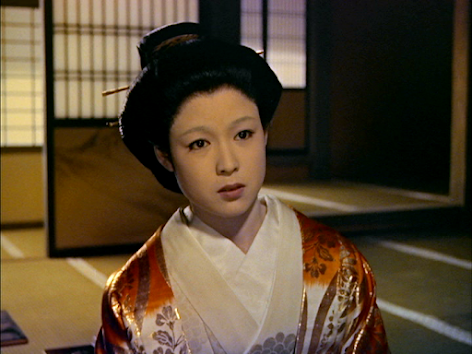 Ayako Wakao
Ayako Wakao1858. Princess Kazu noMiya (Ayako Wakao), the sister of the Emperor, has been engaged to PrinceArisugawa (Raizo Ichikawa) since childhood. Her maid, Yuhide (Fujiko Yamamoto),is more like a best friend than a servant, and it’s assumed that she willbecome the Prince’s concubine if the Princess fails to produce a male heir. Althoughthe two women seem to have little problem with this, the Prince disagrees withthe practice. However, it turns out to be irrelevant as their plans go awry inthe wake of the signing of the Treaty of Amity and Commerce with the UnitedStates. As this action was undertaken by the Tokugawa Shogunate without theEmperor’s blessing, relations between the Shogunate and the Imperial Palacetake a turn for the worse.
Yuhide’s father, Tomofusa (Eijiro Tono), spots anopportunity to improve his own position by putting forward a scheme to politicianTomomi Iwakura (Eitaro Ozawa) and daimyo Tadaaki Sakai (Masao Mishima) toarrange a marriage between the Princess and the new shogun, Iemochi Tokugawa(Yoichi Funaki), in order to cement ties between the shogunate and the palace.The Princess finds herself under pressure to break her engagement; aided byYuhide, she attempts to flee, but this is anticipated by Tomofusa and the planfails. Meanwhile, Yuhide is dealing with her own feelings for the Prince aswell as suspicions about her own parentage when Tomofusa puts her life indanger but she is protected by a mysterious wandering monk (Eijiro Yanagai)…
Produced at their Kyotostudios, this Daiei production was based on a 1953 novel entitled Kojo Kazu no Miya (literally ‘Imperial PrincessKazu of the Palace’) byMatsutaro Kawaguchi (father of actor Hiroshi Kawaguchi), who also happened tobe head of production at Daiei. Although most of the characters are realhistorical figures, Yuhide, Tomofusa and the monk seem to be fictionalinventions. The real Princess Kazu no Miya (1846-77) was only 12 in 1858, whenthis story begins, although that’s not apparent here, nor is the fact that thereal events covered took place over a period of nearly 20 years.
Ayako Wakao isassociated with contemporary roles to such an extent that it seems a littlestrange to see her in period costume, although it’s by no means the onlyoccasion she appeared in a historical drama. This must also be the wimpiestrole she ever played; as portrayed in Suzakumon,Kazu no Miya is a fragile and tragic victim of events, rather than aprotagonist who instigates any of the action. Wakao is fine as always, but it’shard to believe this is the same actress who played the tough prostitute outfor revenge in Irezumi (1966).
Director Kazuo Mori(1911-89) was a competent but not especially distinguished filmmaker who hadworked as an assistant to Daisuke Ito and later directed episodes in the Shinobi no mono and Zatoichi series as well as the previously-reviewed The Saga of Tanegashima, also featuringAyako Wakao (in fact, he directed Wakao nine times). I found Ichiro Saito’sscore quite beautiful and atmospheric at first, but unfortunately it isoverused here and becomes repetitive and sometimes cloying. It’s visually that this film stands out themost, and it’s no surprise that the colour cinematography by Kazuo Miyagawa (afavourite of Mizoguchi and Kurosawa) won a couple of awards, although I thoughtthat the colour timing in the copy I saw could be improved.
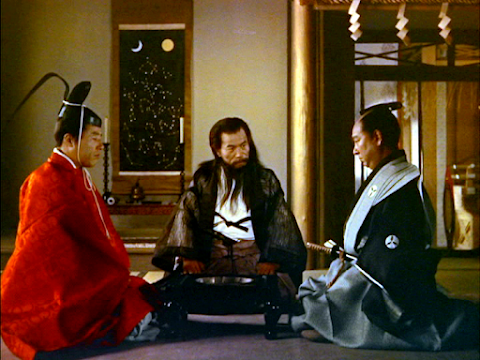 L-R: Eitaro Ozawa, Eijiro Tono and Masao Mishima
L-R: Eitaro Ozawa, Eijiro Tono and Masao Mishima
Suzakumonprobably seemed quite old-fashioned and sentimental even in 1957 (the year of MasakiKobayashi’s Black River and YasuzoMasumura’s debut, Kisses) and there’slittle in the way of action. However, it has enough good qualities to make itworth seeing for fans of Japanese period dramas, including alongside its startrio a strong supporting cast featuring Eijiro Tono, Eitaro Ozawa and MasaoMishima, three stalwarts from Haiyuza, the theatre company and acting schoolwhich also produced Tatsuya Nakadai; Tono has the juiciest role of the threehere and certainly makes the most of it.
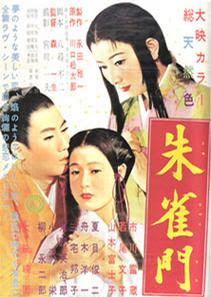
Noteon the title:
It’sunclear why the title of the novel was not used but, according to Wikipedia, “The Suzakumon was the main gate built in the center of the south end of the imperial palaces in the Japanese ancient capitals of Fujiwara-kyō, Heijō-kyō, and later Heian-kyō. The placement followed the ancient Chinese palace model requirements at the time, where Suzaku, the Vermilion Bird was the Guardian of the South. It was said to be the site where foreign dignitaries were received by the Emperor.”
November 12, 2023
The Beauty and the Water Dragon / 美女と怪龍 / Bijo to umi ryu (1955)
Obscure Japanese Film #86
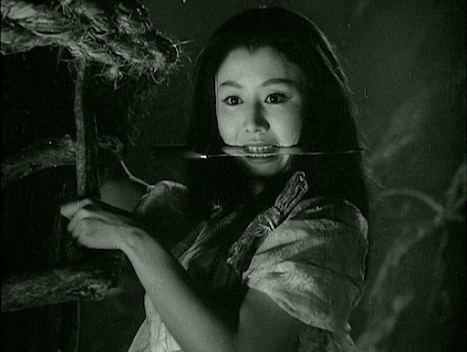 Nobuko Otowa
Nobuko OtowaThis Toei production filmed at their Kyoto studios is anadaptation of a kabuki play dating back to 1684 entitled Narukami after one of its main characters, a monk (here played by Chojuro Kawarasaki) whohas been promised a new temple by the local lord for supposedly changing thesex of the lord’s heir from female to male by means of prayer while the childwas still in the womb. However, Prince Hayakumo (Kunitaro Kawarasaki) suspectsNarukami of being a Tartuffe-like charlatan and fears that providing a newtemple for him will anger a group of monks from a different sect, so he cancelsthe project.
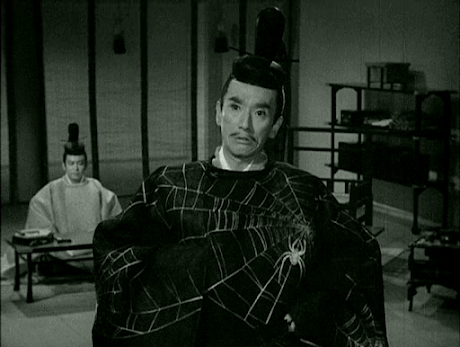 Prince Hayakumo (Hayakumo = fast spider, hence the cool kimono)
Prince Hayakumo (Hayakumo = fast spider, hence the cool kimono)
In revenge, Narukami creates a drought by imprisoning the dragongod in a waterfall. After 100 days without rain, the crops have failed and thepeasants are revolting, so something must be done. It is said that the readingof a certain scroll will break Narukami’s spell, but the only person who mightbe able to decipher the ancient characters is Lady Taema (Nobuko Otowa).Although in reality she also has no clue how to read it, Taema keeps this toherself and decides to use her womanly charms against the celibate priestinstead…
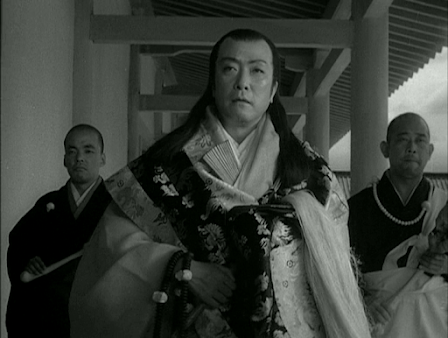 Chojuro Kawarasaki flanked by Shinosuke Ichikawa and Taiji Tonoyama
Chojuro Kawarasaki flanked by Shinosuke Ichikawa and Taiji Tonoyama
Kozaburo Yoshimura’s film was made to celebrate the 25th anniversary of Zenshinza, a Tokyo-based kabuki troupe, and many Zenshinza actors are featured among the cast, including Chojuro Kawarasaki as Narukami. However, this was not the first time Zenshinza had been involved in a film project (the 1937 picture Humanity and Paper Balloons being another example), and not all of the actors featured here were members of the troupe. The most familiar faces to film fans will probably be Nobuko Otowa and Taiji Tonoyama, both favourites of filmmaker Kaneto Shindo, who wrote the witty screenplay for this adaptation.
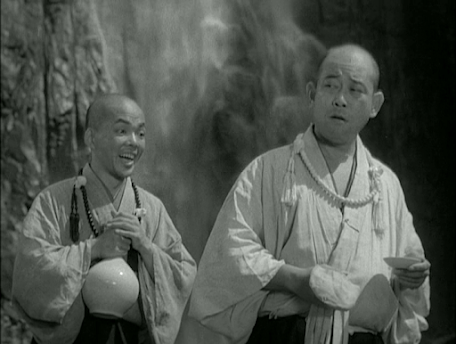 Shinosuke Ichikawa (left) and Taiji Tonoyama (right)
Shinosuke Ichikawa (left) and Taiji Tonoyama (right)Tonoyama and Shinosuke Ichikawa (in his only film role; presumably a member of Zenshinza) are great fun as Hakkun and Kokkun, bickering apprentice monks/servants to Narukami who are more interested in alcohol, women and forbidden snack foods than spiritual training. This is purely speculative, but I wonder whether they might have inspired Kurosawa to create the two squabbling peasants played by Minoru Chiaki and Kamatari Fujiwara in The Hidden Fortress (1958), which later famously inspired George Lucas to create C-3PO and R2-D2 in Star Wars. We’ll probably never know, but the date fits and it’s highly likely that Kurosawa would have seen The Beauty and the Water Dragon.
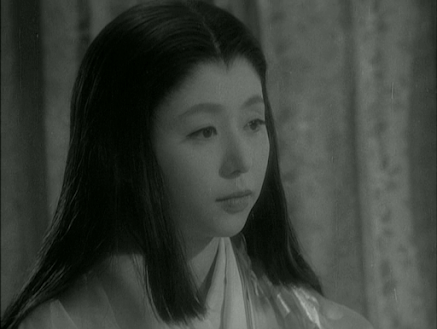 Nobuko Otowa
Nobuko OtowaConsidering its basis in one of the canonical kabuki plays and the fact that a kabuki company was heavily involved in the production, it’s somewhat surprising that director Kozaburo Yoshimura’s film is not in the least precious, even at one point featuring a clearly anachronistic dance which looks like something you might see in a 1950s nightclub, but probably not in the Heian era, during which this story is set. However, it’s worth noting that Zenshinza were one of the more progressive kabuki troupes at the time, featuring as they did a number of female performers when the majority of such theatre companies still used only male actors even in the female roles.
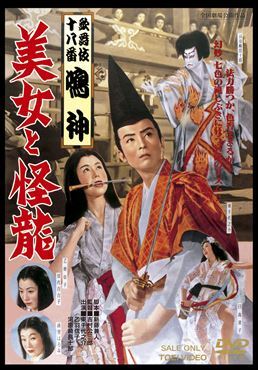
The film is bookended by scenes of the play being performed in traditional style in a theatre, but the bulk of the film abandons the kabuki style and features more naturalistic acting. In Yoshimura’s version, The Beauty and the Water Dragon is very much a comedy, and I would assume that it was traditionally played straighter than it is here. In any case, of the 10 Yoshimura films I’ve seen so far, this is my joint favourite alongside his 1951 version of The Tale of Genji, and in my opinion it’s a very fine film quite unlike anything else I’ve seen. Special mention should be made of the beautiful cinematography by Yoshio Miyajima, who later became Masaki Kobayashi’s right-hand man.
Note about the title:
The complete title is 歌舞伎十八番「鳴神」美女と海龍 / Kabuki juhachiban ‘Narukami’ Bijo to umi ryu, which translates as Kabuki 18 "Narukami": The Beauty and the Water Dragon (the ‘18’ refers to the fact that Narukami is one of the 18 kabuki plays selected by top kabuki actor Danjuro Ichikawa VII [1791-1859] as having special merit).
November 5, 2023
Doro inu / どろ犬 (aka 'The Desperate', 1964)
Obscure Japanese Film #85
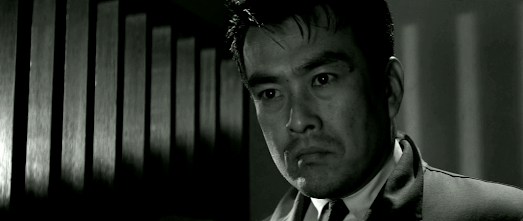 Minoru Oki
Minoru OkiThis Toei productionstars Minoru Oki (perhaps best known as the main cop in the 1958 classic Stakeout) in another rare leading roleas Cho, a respected senior detective with 20 years’ service under his belt. Heseems himself as a good guy and hates criminals with a passion, but he also secretlykeeps a mistress, Chiyo (Chisako Hara), who is the wife of a yakuza currentlyspending time behind bars. Unfortunately for him, a slimy blackmailer,Yamaguchi (Ko Nishimura, who else?), finds out about this relationship and usesthe information to compromise Cho. Things are further complicated by anunlikely friendship that develops between Chiyo and Yamaguchi’s brother (KunieTanaka), who has learning difficulties, and by Cho’s colleague, DetectiveTokumochi (Hisashi Igawa), who has known Yamaguchi since they were children. AsCho struggles to keep both his reputation and self-respect intact, he findshimself increasingly on the wrong side of the law he has sworn to uphold…
Based on a 1963 novelby Shoji Yuki entitled Yoru no owaru toki(‘When the Night Ends’), this obscure noir is a real find. The dark, shadowycinematography of Masahiko Iimura suggests a world of perpetual night, MasaruSato provides an excellent modernist score, and there’s a typically memorableperformance by the great Ko Nishimura, probably the closest thing the Japanesecinema had to Peter Lorre. He must have been a dedicated actor, too, as in onescene he allows himself to be literally thrown around a room for severalminutes – without the aid of a stunt double – by Minoru Oki, perhaps aspunishment for stealing the movie.
Debut director TakaharuSaeki (1927-2018), who had worked as an assistant to Tomotoka Tasaka, handlesall aspects with admirable skill, so why, you may ask, did he not make anotherfeature film for 20 years? It turns out that shortly after completing thispicture, he led a demonstration outside the home of Toei president HiroshiOkawa, who promptly had him exiled to their TV production arm. In 1984, hefinally got a chance to make one more film; entitled A Train Ran on the Plateau, it has long since fallen into obscurity.
The Japanese title translatesuneasily to English. ‘Inu’ means ‘dog’, but ‘doro’ can mean ‘mud’ or ‘thief’,so it’s unclear which meaning is intended, which is perhaps why the subtitlerof the print I saw has christened the film ‘The Desperate.’ Kudos to them,anyway, as they have done a fine job.
October 31, 2023
The Military Policeman and the Ghost / 憲兵と幽霊 / Kenpei to yurei (1958)
Obscure Japanese Film #84
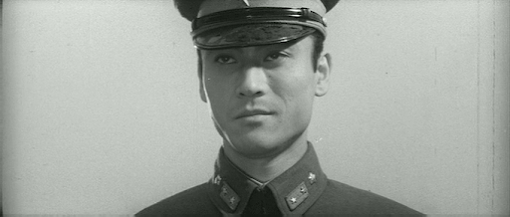 Shigeru Amachi
Shigeru Amachi1941: Military policeman LtNamishima (Shigeru Amachi) is extremely miffed when Akiko (Nahoko Kubo), thewoman he fancies, marries Corporal Tazawa (Shoji Nakayama). Later, when asubordinate loses some classified documents, Namishima decides to take the oldmaxim of ‘all’s fair in love and war’ a little too literally and frame Tazawain order to get his hands on his wife. Tazawa receives the death sentence as atraitor and is shot by firing squad, but not before he has placed a curse onNamishima, vowing to get revenge from beyond the grave. However, the dastardlylieutenant continues unabashed with his evil scheme – until Tazawa’s brotherbecomes an MP and begins investigating his brother’s death…
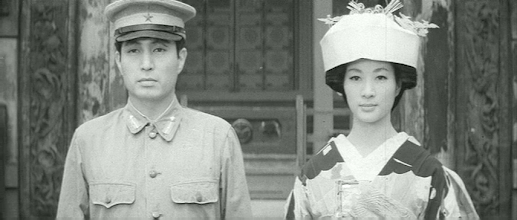 Shoji Nakayama and Nahoko Kubo
Shoji Nakayama and Nahoko KuboThis Shintohoproduction was ordered by producer Mitsugu Okura, who assigned director NobuoNakagawa to come up with a new film to cash in on the (presumably modest) boxoffice success of the previous year’s The Military Policeman and the Dismembered Beauty. Like that picture, this alsofeatures actors Shoji Nakayama and Shigeru Amachi, but here they play differentcharacters and the story is unrelated. The earlier film had been directed byKyotaro Namiki, who seemed not to be terribly at home in the horror genre, sothe choice of Nakagawa – who had already enjoyed success with several suchfilms – makes perfect sense.
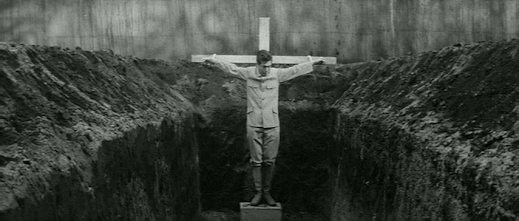 Shoji Nakayama contemplates the work of some over-enthusiastic gravediggers
Shoji Nakayama contemplates the work of some over-enthusiastic gravediggersSurprisingly, JapaneseWikipedia suggests that Nakagawa originally developed a straightforwardthriller with screenwriter Yoshihiro Ishikawa and the supernatural element wasadded later at Okura’s insistence, and it does feel like something of anafterthought, most of the (fairly mild) spooky stuff being held back for theclimax. In any case, Nakagawa’s film is much superior to the previous one. Heand cinematographer Tadashi Nishimoto were able to make use of the newwidescreen format and clearly went to considerable trouble in shooting scenesfrom unusual angles, making this an often visually arresting piece of work,even if they occasionally get a bit too carried away with tilting the camerathis way and that.
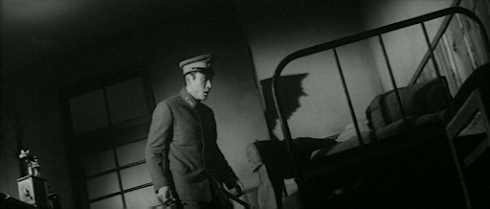 Shigeru Amachi
Shigeru AmachiThe film is unusual infeaturing a villain as the main character, and it’s Shigeru Amachi in this rolewho gives the strongest performance, although he gets stiff competition fromYoko Mihara as the bad girl of the piece. It’s also fun to see Masayo Banri asa sexy nightclub dancer, but perhaps best of all is an absolutely pricelessmoment of (possibly unintentional) black comedy involving a corpse disposal.
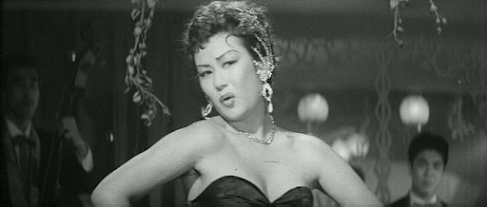 Yoko Mihara
Yoko Mihara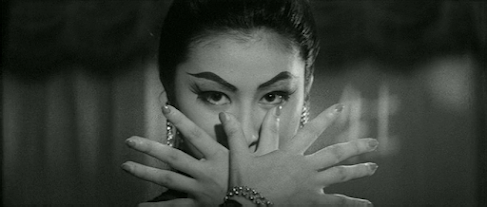 Masayo Banri
Masayo Banri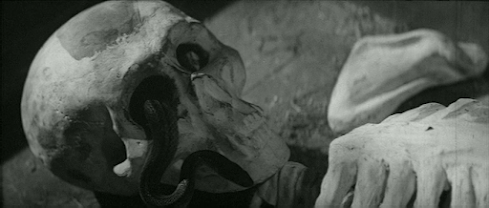
October 23, 2023
Pu-san / プーサン/ Mr Pu (1953)
Obscure Japanese Film #83
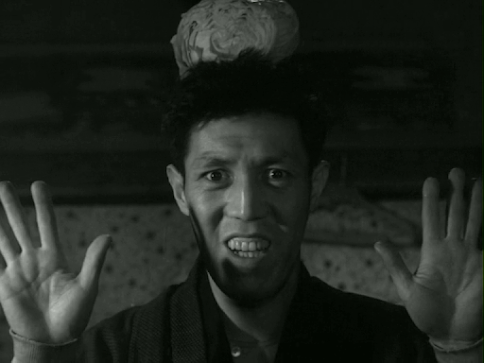 Yunosuke Ito with cabbage
Yunosuke Ito with cabbageDuring the war,Japanese filmmakers were severely restricted by the authorities in theircountry, who would not allow any content that could be perceived as beingcritical of the military or having a pacifist message. After the war, thecountry’s filmmakers remained restricted, though the nature of the censorshipchanged – the occupying Americans banned anything they felt promoted feudalism,while encouraging material with a pro-democracy message, such as the previouslyreviewed A Descendant of Urashima Taro.The occupation ended in 1952, and it’s no coincidence that Kon Ichikawa’s Pu-san appeared the following year when thefilm industry was finally free of political restrictions for the first time inover a decade.
In Pu-san, Ichikawa gleefully indulges in a vulgarity that would havebeen frowned upon in previous years, while also emphasizing the fact thatidealism has little value in a world where people are struggling simply to getenough to eat and keep a roof over their heads. This situation enablesemployers to exploit workers like Noro (Yunosuke Ito), a downtrodden39-year-old maths teacher whose boss (Daisuke Kato) gives him a stark choice: teachextra night classes with no additional pay, or leave. Noro is a classic ‘loser’whose unassuming manner attracts bad luck – this crisis happens shortly afterhe has been knocked down by a truck in Ginza and injured his hand. A widowerand war veteran, he lodges with a couple in their 50s and is in love with their24-year-old daughter, Kanko (Fubuki Koshiji), but his feelings are notreciprocated, as he learns only too well after overhearing a conversationbetween Kanko and her mother through the paper-thin wall of his room.Meanwhile, Noro’s students are flirting with communism and his old friends arereduced to selling items on the black market…
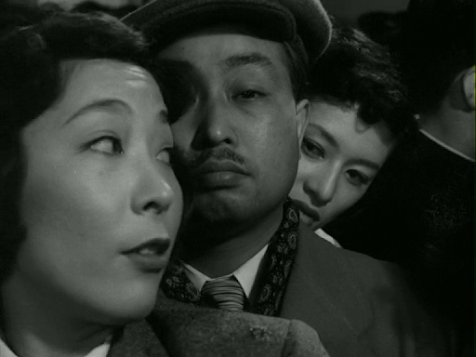 Fubiki Koshiji, Daisuke Kato and Yoko Sugi
Fubiki Koshiji, Daisuke Kato and Yoko Sugi
Such a scenario may notseem an obvious choice for comedy, but that’s exactly what this Toho productionis – and a determinedly eccentric and anarchic one to boot. Based on a comicstrip by Taizo Yokoyama (who makes a cameo appearance as a policeman), it’sunclear (at least to me) why Pu-san is referred to as Noro throughout the film.In any case, Ichikawa seems to be raising two fingers to the establishmenthere, and it’s probably the earliest Japanese film I’ve seen to have that ‘newwave’ vibe familiar from later pictures such as Shohei Imamura’s Pigs and Battleships (1959). It’s not atall funny but certainly ironic that the only way Noro can survive in the end isby taking a highly dubious job packing machine gun bullets.
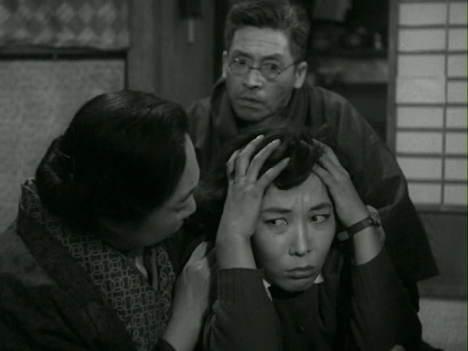 Eiko Miyoshi, Kamatari Fujiwara and Fubiki Koshiji
Eiko Miyoshi, Kamatari Fujiwara and Fubiki Koshiji
Long-faced characteractor Yunosuke Ito has not always played such meek and mild types, but provesto be a good choice in what was a rare leading role for him. However, I feltthat Fubuki Koshiji (better known as a singer) stole the show here with hersuperb comic performance as the stubborn Kanko (a character originating in aseparate comic strip by the same artist) – her facial expressions are oftenpriceless.
Also notable in aremarkable ensemble cast featuring a number of Kurosawa regulars are KeijuKobayashi as a young policeman, a very young-looking Kaoru Yachigusa as anurse, Isao Yamagata as a friend of Noro’s fallen on hard times, Eiko Miyoshias Noro’s opportunistic landlady, Kamatari Fujiwara as her more understandinghusband, Yoko Sugi as Kanko’s best friend and, of course, the great DaisukeKato as Noro’s nasty boss – the kind of guy who smiles and tells you it’s allfor your own good while casually cutting your throat.
Ably abetted byKurosawa cameraman Asakazu Nakai, Ichikawa shows considerable invention throughout,often using extreme close-ups and unusual framing but, overall, I’d say that Pu-san is more in the nature of afascinating oddity than a complete success – the first few scenes flitconfusingly from one seemingly random group of characters to another and itremains all over the place until the end. In fact, I doubt I’ve seen another filmwith as many extraneous characters – a narrower focus would surely have been preferable.
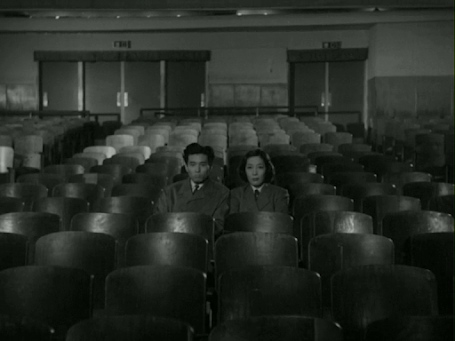 Composer Toshiro Mayuzumi in a rare screen appearance with Fubiki Koshiji
Composer Toshiro Mayuzumi in a rare screen appearance with Fubiki Koshiji
October 18, 2023
A Descendant of Urashima Taro / 浦島太郎の後裔 / Urashima Taro no koei (1946)
Obscure Japanese Film #82
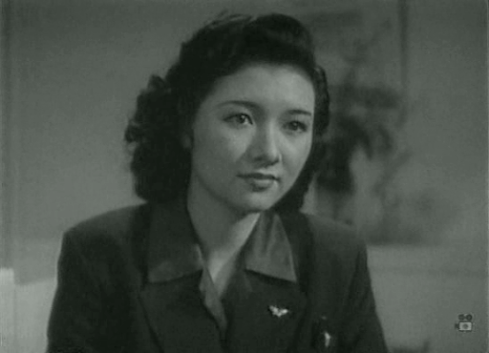 Hideko Takamine
Hideko TakamineTaro Urashima is the mythical hero of a Japanese folk tale who rode on the back of a turtle which took him to an underwater palace where he stayed for what he thought was a few days before returning home to find that centuries had passed. The hero of this Toho production, Goro Urashima (Susumu Fujita, the star of Kurosawa’s Sanshiro Sagata films), is a former soldier newly returned to Japan after being stranded for 18 months on a south seas island. Sporting an impressive beard, he yearns for peace and democracy now that the war is over. When he is interviewed on the radio about his experiences, he tells of how the island natives would sometimes gather and let out a haunting, mournful cry which moved him deeply. He demonstrates the sound over the airwaves, after which it resonates with Japan’s workers, who begin imitating it.
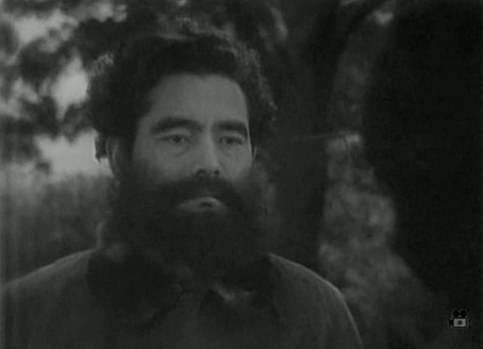 Susumu Fujita
Susumu FujitaMeanwhile, young reporter Akiko (Hideko Takamine) – accused of having ‘pretty face, empty head’ by her boss (Haruko Sugimura) – spots an opportunity and tracks down Urashima for an interview. Hoping to milk the story for as long as possible, she suggests that he perform his cry from the roof of the Diet building for several days, and she runs a series of articles in which she claims that he is a descendant of Taro Urashima. Goro’s wail becomes a rallying call and the workers build him up into their champion. But soon he is being unwittingly used by a fake democratic group called the Japanese Happiness Party, who actually intend to exploit the workers mercilessly once they get into power…
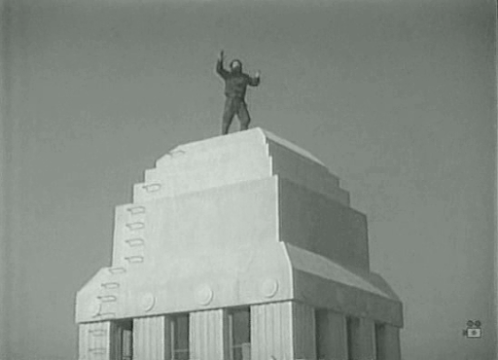
With its obvious pro-democracy, beware-false-prophets message, this is the sort of film that the occupying Americans strongly encouraged after the war. In fact, the story owes much to the Frank Capra movies Mr Smith Goes to Washington (1939) and Meet John Doe (1941), but here it’s all a bit po-faced. This type of material was clearly not director Mikio Naruse’s forte and it remains a real anomaly among his films – he did not repeat the error and only collaborated with screenwriter Yasutaro Yagi on one further occasion for the more enjoyable comedy Conduct Report of Professor Ishinaka (1950).
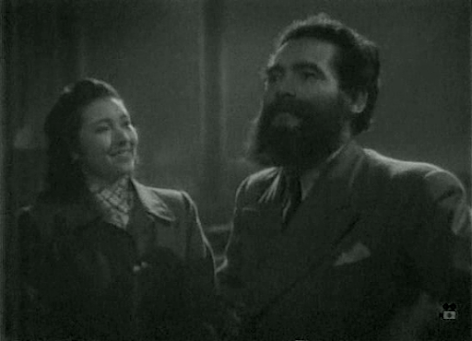
Apart from Hideko Takamine, it’s hard to find much to like about this film – Fujita seems uncomfortable in his role, while the music score is quite poor, perhaps explaining why it would be the final of just three screen credits for composer Toshio Yamada. Worse still, Goro’s cry sounds like a bad Tarzan impression and, unfortunately, it soon becomes grating and is repeated ad infinitum.
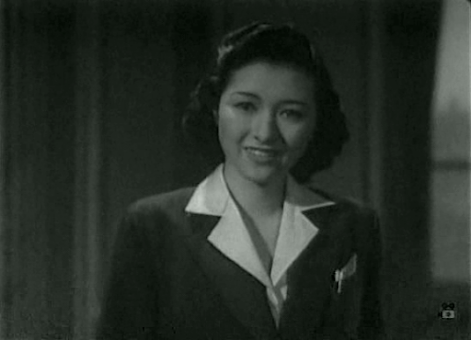
October 13, 2023
Hi no tori / 火の鳥 / Phoenix (1956)
Obscure Japanese Film #81
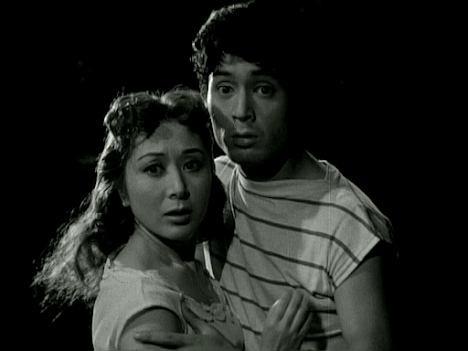 Yumeji Tsukioka and Tatsuya Nakadai
Yumeji Tsukioka and Tatsuya Nakadai
This Nikkatsu production stars Yumeji Tsukioka as Emi, a half-Japanese, half-British actress who belongs to a Shingeki theatre company (i.e. one specialising in performing Japanese translations of dramas by playwrights such as Shakespeare and Chekhov). The film opens with Emi learning that her British father has passed away suddenly. Despite being shocked and saddened, she manages to pull herself together and deliver a good performance in the evening. After the show, she’s approached by two men, a producer (Toru Abe) and director (Nobuo Kaneko) who work in the film industry and want to give her a screen test, but first she must seek permission from Tajima (Shin Date), the director of the theatre company with whom she is having an affair. On her way home, she meets her ex, Sugiyama (Tatsuya Mihashi), who disapproves of her career and wants to get back together, but she brushes him off. They have a bitter argument, after which she is escorted home by Toku (Shiro Osaka), a lighting technician at the theatre who has a crush on her, although she regards him only as a friend. At home, she is visited by Tajima, who gives his approval for her screen test the following day.
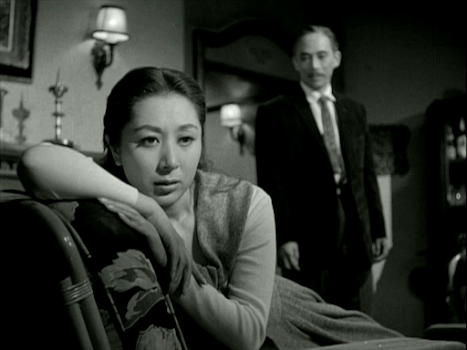 Tsukioka with Shin Date
Tsukioka with Shin DateAt the studio, she encounters a young actor, Keiichi (Tatsuya Nakadai), and feels a strong attraction to him which seems to be mutual. Later, at a birthday party for one of the studio’s stars (real-life star Mie Kitahara), she dances with Keiichi. This is noticed by the producer and director, who decide they make a good couple and cast them together in a film entitled Phoenix. Emi and Keiichi soon find themselves a hot topic in the gossip columns, but when the studio holds the first test screening of Phoenix, Keiichi is mysteriously absent. It turns out that he has been arrested for his part in a demonstration against the presence of American military bases in Japan. As Emi becomes more involved with Keiichi, she begins skipping rehearsals at her theatre company and her relationship with Tajima becomes increasingly tense. To add to her troubles, she discovers that Keiichi has been two-timing her with a young actress, Kazuko (Sanae Nakahara), who belongs to the same student theatre group as himself.
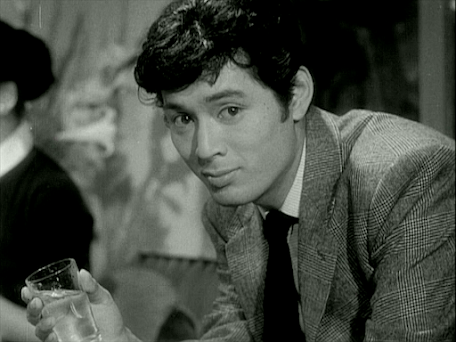
I couldn’t help finding the content of this film rather inconsequential and I wasn’t sure how I was supposed to feel about Emi or why I should particularly care. She is certainly not an entirely sympathetic character – she shirks her responsibility to the theatre and treats her older sister (Hisano Yamaoka) like a servant. But of course, it could be argued that this makes her more believable and interesting than the straightforwardly ‘good’ heroines typical at the time.
 A first edition copy of the original novel.
A first edition copy of the original novel.
The film was based on a bestseller of the same name first published in 1953 and written by Sei Ito, a writer popular at the time, so that’s one reason for the film’s existence. The other is to provide a vehicle for Yumeji Tsukioka, a talented actress probably best-remembered today for her leading roles in Hiroshima (1953) and The Eternal Breasts (1955). Tsukioka was Nikkatsu’s top female star at the time. The following year, she married the director of this picture, Umetsugu Inoue, a prolific filmmaker seemingly able to turn a deft hand to almost any given genre. He was also known as Umeji, making the couple Umeji and Yumeji.
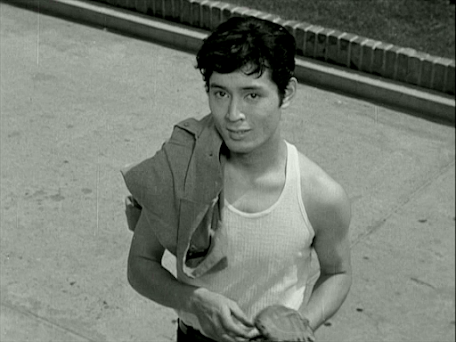
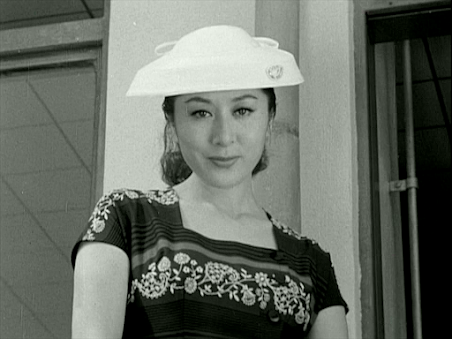
Today, Hi not tori is most likely to be of interest for providing Tatsuya Nakadai with his first substantial film role (it was Yumeji Tsukioka herself who suggested him for the part). Inoue gives him a fantastic entrance around 26 minutes in when Emi notices a casually confident Keiichi strolling past below her with his shirt off and looking up at her admiringly. In fact, it looks as if Nikkatsu’s intention was to introduce the 23-year-old Nakadai as a new sex symbol. However, in some of his later scenes, he’s a trifle awkward and his inexperience shows – perhaps that’s why it would be a few more films down the line before he made his true breakthrough with Black River (1957). Of course, Tsukioka and Nakadai are both playing characters rather like themselves, although it was actually Nakadai who had the Shingeki background.
Hi no tori provides an interesting behind-the-scenes glimpse of the real Nikkatsu studios, and it’s probably those with a particular affection for Japanese films of this vintage who will appreciate this one the most, not to mention enjoy the uncredited cameos by Mie Kitahara, Frankie Sakai, Masumi Okada, Hiroyuki Nagato, Izumi Ashikawa and Rentaro Mikuni.
NB. Nakadai later appeared in a 1978 film with the same title directed by Kon Ichikawa which has nothing whatever to do with this one.
Watched without subtitles.
September 30, 2023
Onna no kunsho /女の勲章 (‘A Woman’s Medal’, 1961)
Obscure Japanese Film #80
This Daiei production is based on a novel by Toyoko Yamasaki (1924-2013), an author of best-selling novels which often dealt with scheming, corruption and scandal in various industries and were based on interviews with insiders. Many of these were turned into successful films, such as The Great White Tower (the medical industry), A Splendid Family (the banking industry) and Barren Zone (the aviation industry). She became the subject of scandal herself for a while when she faced several accusations of plagiarism, but ultimately these failed to do any serious damage to her career. However, Yamasaki was more popular with readers than critics, most of whom saw little of literary merit in her work. Onna no kunsho, published the year of the film’s release, was the first example of what became the familiar Yamasaki formula and is set in the world of the fashion industry.
Machiko Kyo stars as Shikiko, a talented fashion designer in Osaka* who forms an alliance with an ambitious business manager, Ginshiro (Jiro Tamiya). Unfortunately, behind the fake concern for her welfare, Ginshiro is an unscrupulous character who seeks only to exploit her for his own ends. After seducing Shikiko, he talks her into signing off on a lot of dodgy deals, then proceeds to work his way through her senior designers, Rinko (Ayako Wakao), Katsumi (Junko Kano) and Tomie (Tamao Nakamura), seducing each in turn and using them to expand the company and consolidate his own position.
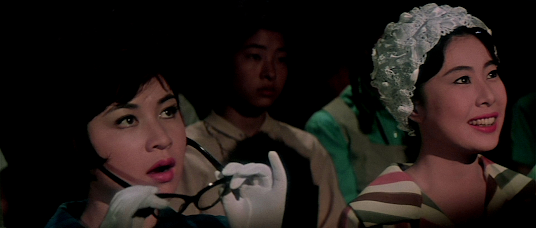 Junko Kano and Tamao Nakamura
Junko Kano and Tamao NakamuraAlthough Tamiya later played a similarly ruthless character in the 1966 film of Yamasaki’s The Great White Tower – which became his signature role – Ginshiro is an unusual part for Tamiya in that he talks a lot and is not at all moody, being almost entirely unfazed by whatever difficult situation may occur. Tamiya handles this well and holds his own among a cast dominated by formidable female stars. Most of the female characters here turn out to be just as duplicitous as Ginshiro, and when somebody finally shows some moral backbone, it’s in the unlikely form of a journalist (the excellent Eiji Funakoshi). Journalists are seldom depicted as the most ethical of people, so the fact that Yamasaki was a former journalist herself might not be entirely coincidental.
Kaneto Shindo’s screenplay results in a very talky film with largely unsympathetic characters I found it difficult to care about very much, making it a stark contrast to the last film I reviewed here, A Night to Remember, also starring Ayako Wakao and Jiro Tamiya and directed by Kozaburo Yoshimura. I had the distinct impression that Yoshimura was less invested in this film as the direction is competent but seldom notable. However, Onna no kunsho does have a highly effective ending and was presumably successful at the box office as it has been remade for television three times since.
*Shikiko is said to have been based on real-life Osakan fashion designer Yasuko Ueda (1906-96).
